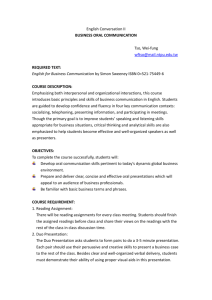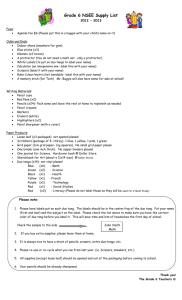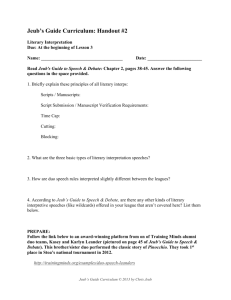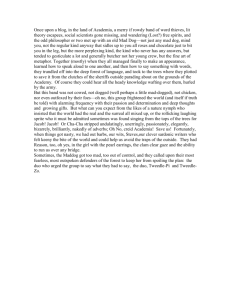A 5 DDENDUM M
advertisement
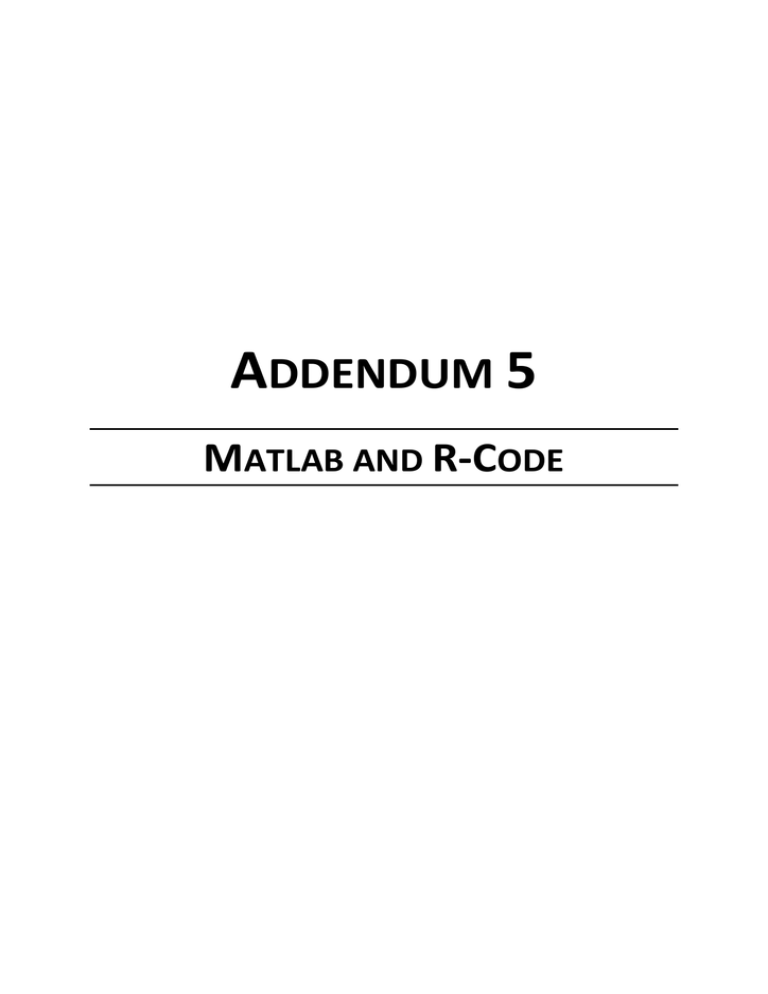
ADDENDUM 5 MATLAB AND R‐CODE ADDENDUM 5 MATLAB AND R‐CODE This addendum includes the most relevant Matlab and R‐scripts developed during the course of this research and has 5 subdivisions with code related to chapters 2 to 6. Text comments are in italics and gray font and are preceded by % for the Matlab code and by # for the R‐code. The script is followed by ‘…’ when the Matlab code continues on the next line. CODE RELATED TO CHAPTER 2: SPECIES ASSEMBLY RULES This paragraph summarises the Matlab code for the two swapping algorithms for presence/absence data. The scripts for calculating the co‐occurrence indices for the original data matrix are not shown here, since they can be easily derived from the code below. The code concerns only the feeding type 1A. Adapting the code for the other feeding types or all the data can be easily achieved by replacing ‘1A’ by another feeding type or by ‘AllData’. Swap 1 for presence/absence data %% data needed % replicodes_1A = file with three columns about data of feeding type 1A % name of the replicate// number of the sample// number of replicates in the sample % matrix_1A = presence/absence matrix with % replicates in rows and species in columns for aantal=1:10 % aantal = number of files with ‘aantalRand’ null models aantalRand=100; % number of null models in one loop (‘aantal’) % load data load('replicodes_1A'); load('matrix_1A'); replicodes_nieuw=replicodes_1A; matrix_nieuw=matrix_1A; clear matrix_1A; clear replicodes_1A; aant=int2str(aantal); [X,Y]=size(matrix_nieuw); % Calculate row number in p/a matrix where a new sample starts N=1; x=1; while x<X aantalReps=replicodes_nieuw{1,3}(x); rijen(N)=x; N=N+1; x=x+aantalReps; end 275 ADDENDUM 5 samples=N‐1; aantalRep=X; aantalSpec=Y; probleem=0; resultaat_null=zeros(aantalRand,8); rij=1; rij1=1; for rand=1:aantalRand for n=1:samples % repeat swapping algorithm for all samples aantalReps=replicodes_nieuw{1,3}(rijen(n)); % submatrix = data of 1 sample with ‘aantalReps’ replicates submatrix=[]; submatrix=matrix_nieuw(rijen(n):(rijen(n)+aantalReps‐1),:); MM=1; % delete species which do not appear in the sample kolomleeg=zeros(Y,1); for y=Y:‐1:1 if submatrix(1:aantalReps,y)==zeros(aantalReps,1) submatrix(:,y)=[]; kolomleeg(y,1)=1; % remember the empty species columns end end [A,B]=size(submatrix); swaps=500; sw=0; aantalSwaps=0; if A>1 && B>1 % try swaps if the remaining matrix contains more % than 1 replicate and more than 1 species while sw<swaps % try 1000 swaps % choose randomly 2 replicates and 2 species randomNr1 = randint(2,1,[1,A]); randomNr2 = randint(2,1,[1,B]); % check if 2 different species and 2 different replicates are chosen if (randomNr1(1)~= randomNr1(2)) && … (randomNr2(1)~= randomNr2(2)) sw = sw+1; % check if matrix is like [0 1; 1 0] or [1 0; 0 1] if ((submatrix(randomNr1(1),randomNr2(1))== ... submatrix(randomNr1(2),randomNr2(2))) && ... (submatrix(randomNr1(1),randomNr2(2))== ... submatrix(randomNr1(2),randomNr2(1))) && ... (submatrix(randomNr1(1),randomNr2(1))~= ... submatrix(randomNr1(1),randomNr2(2)))) % perform swap submatrix(randomNr1(1),randomNr2(1)) = ... abs(submatrix(randomNr1(1),randomNr2(1))‐1); submatrix(randomNr1(1),randomNr2(2)) = ... abs(submatrix(randomNr1(1),randomNr2(2))‐1); submatrix(randomNr1(2),randomNr2(1)) = ... abs(submatrix(randomNr1(2),randomNr2(1))‐1); submatrix(randomNr1(2),randomNr2(2)) = ... 276 MATLAB AND R‐CODE abs(submatrix(randomNr1(2),randomNr2(2))‐1); aantalSwaps=aantalSwaps+1; end end %if end %1000 swap attempts end % repair the submatrix by adding absent species in submatrix Mr=1; NN=1; submatrix2=[]; for y=1:Y if kolomleeg(y,1)==1 submatrix2(1:aantalReps,y)=zeros(aantalReps,1); else submatrix2(1:aantalReps,y)=submatrix(1:aantalReps,NN); NN=NN+1; end end clear kolomleeg if NN‐1~=B probleem=1; end % put the swapped replicates back in the overall matrix matrixNull(rijen(n):(rijen(n)+aantalReps‐1),:)=submatrix2; clear submatrix2; clear submatrix; end %% calculate the indices on the randomised data matrix [X,Y]=size(matrixNull); N=1; x=1; Comb=Y*(Y‐1)/2; % number of species pairs % C‐score NCU=1; CU=0; Tsc=0; Scr=0; checker=0; for y1=1:(Y‐1) % species y1 for y2=(y1+1):Y % species y2 (different from species y1) % C ri=sum(matrixNull(:,y1)); rj=sum(matrixNull(:,y2)); % calculate how many times species y1 and y2 appear together in a % replicate (S) som=matrixNull(:,y1)+matrixNull(:,y2); verschil=abs(matrixNull(:,y1)‐matrixNull(:,y2)); S=sum(som‐verschil)/2; CU=CU+(ri‐S)*(rj‐S); Tsc=Tsc + S*(aantalRep+S‐ri‐rj); %T Scr=Scr+S; %S if max((som))==1 %checker checker = checker+1; end NCU=NCU+1; 277 ADDENDUM 5 end end Cscore=CU/(Y*(Y‐1)/2); Tscore=Tsc/(Y*(Y‐1)/2); Sscore=Scr/(Y*(Y‐1)/2); % V‐score ST2=0; Tgem=sum(sum(matrixNull))/aantalRep; for j=1:aantalRep Tj=sum(matrixNull(j,:)); ST2=ST2+(Tj‐Tgem)^2; end ST2=ST2/aantalRep; sigmai2=0; for i=1:aantalSpec ni=sum(matrixNull(:,i)); sigmai2=sigmai2+(ni/aantalRep)*(1‐(ni/aantalRep)); end Vscore=ST2/sigmai2; clear matrixNull resultaat_null(rand,1)=Cscore; resultaat_null(rand,2)=Tscore; resultaat_null(rand,3)=Sscore; resultaat_null(rand,4)=Vscore; resultaat_null(rand,5)=checker; end fileN1=['resultaat_STCV_null_Swap1_1A_' aant]; save(fileN1,'resultaat_null') clear end Swap 2 for presence/absence data In this paragraph only the code about the swapping algorithm is shown. The rest of the code is equal to what is shown above. [A,B]=size(submatrix); swaps=1000; sw=0; aantalSwaps=0; if A>1 && B>1 while sw<swaps % choose randomly 2 replicates and 1 species randomNr1 = randint(2,1,[1,A]); randomNr2 = randi(B); % check if it concerns 2 different replicates 278 MATLAB AND R‐CODE if (randomNr1(1)~= randomNr1(2)) sw = sw+1; w1=submatrix(randomNr1(1),randomNr2); w2=submatrix(randomNr1(2),randomNr2); % perform swap submatrix(randomNr1(1),randomNr2) = w2; submatrix(randomNr1(2),randomNr2) = w1; % check if no empty replicates are present % if one of the replicates contains no species, restore the submatrix if sum(submatrix(randomNr1(1),:))==0 || ... sum(submatrix(randomNr1(2),:))==0 submatrix(randomNr1(1),randomNr2) = w1; submatrix(randomNr1(2),randomNr2) = w2; end clear w1; clear w2; end % if end % 1000 swap attempts end Histograms groep='1A' % define feeding type Nrandom=100; % number of null models in one file NrandomTot=1000; % total number of null models fileN1=['resultaat_ori_' groep '.mat']; % values of original data matrix load(fileN1) % load all values of null models for aantal=1:10 aant=int2str(aantal) fileN1=['result_random_' aant '_' groep]; load(fileN1) resultaat((aantal‐1)*Nrandom+1:aantal*Nrandom,:)=resultaat_null; clear resultaat_null end fid = fopen('labels_hor_as.txt'); labelslijst = textscan(fid,'%s'); % names of labels of x‐axis fclose(fid); % calculate the two‐sided 95% confidence interval of the 1000 null models quant97=ceil(NrandomTot*97.5/100); [X,Y]=size(resultaat); resultaat(1000,:)=[]; for kolom=1:Y B=sort(resultaat(:,kolom)); grens(kolom,1)=B(quant97); 279 ADDENDUM 5 clear B end for kolom=1:Y B=sort(resultaat(:,kolom),'descend'); grens2(kolom,1)=B(quant97); clear B end for kolom=1:Y % define minimum and maximum value of x‐axis maximum=max(resultaat(:,kolom)); minimum=min(resultaat(:,kolom)); if resultaat_ori(kolom)>maximum maximum=resultaat_ori(kolom); end if resultaat_ori(kolom)<minimum minimum=resultaat_ori(kolom); end maximum=(maximum‐minimum)/20 + maximum; minimum= ‐(maximum‐minimum)/20 + minimum; hist(resultaat(:,kolom)); % plot histogram h = findobj(gca,'Type','patch'); set(h,'FaceColor',[0.7,0.7,0.7],'EdgeColor',[0.3,0.3,0.3]) h2 = findobj(gca,'Type','axes'); set(h2,'FontSize',30) set(gca,'xlim',[minimum maximum]); hold on x=resultaat_ori(kolom)*ones(1,11); y=0:20:200 x2=grens(kolom,1)*ones(1,11); y2=0:20:200 x3=grens2(kolom,1)*ones(1,11); y3=0:20:200 % plot original value on histogram plot(x,y,'color','k','LineWidth',3) hold on % plot upper border of 95% CI on histogram plot(x2,y2,'color','k','LineWidth',3,'LineStyle','‐‐') hold on % plot lower border of 95% CI on histogram plot(x3,y3,'color','k','LineWidth',3,'LineStyle','‐‐') xlabel(labelslijst{1,1}{kolom,1},'FontSize',38) ylabel('Frequency','FontSize',36) fname=['hist_dens_' int2str(kolom) '_' groep '_190411.jpg' ]; print('‐r100','‐djpeg',fname) hold off end 280 MATLAB AND R‐CODE CODE RELATED TO CHAPTER 3: ARTIFICIAL NEURAL NETWORKS Find optimal number of neurons The optimal network transfer functions and learning methods where at this point already defined. Finding the optimal total network can be realised by adding two more loops (one for the transfer function and one for the learning method) within the neuron loop. %% calculate neural networks for different neurons % samples with geographical coordinates (replicate ID, latitude, longitude) stations = load('stations_011007_4.csv'); % data matrix with environmental variables in columns,replicates in rows Pfile = load('omgeving011007_4.csv'); % target: target values (biodiversity indices) in columns, replicates in rows Tfile = load('target_compl_sampleIndependent_011007_4.csv'); % file with stratified data: column 8 assigns fold for replicate fanny=load('fanny_clustering_011007_4.csv'); [Pr,Pk]=size(Pfile); coeff = 0.5; % minimum correlation coefficient to retain neural network neuronStart=1; neuronInterval=1; neuronEind=6; datum=date; % date is used in file name NZdata=Pfile; [Ta1,Ta2]=size(Tfile); % Preprocess environmental variables: mean = 0 and standard deviation = 1 P1 = NZdata.'; [P2,P2info] = mapstd(P1); % reduce number of environmental variables by principal component analysis % keep only those variables which contribute more than 1% of the variation % in the data [P2,P2infoPCA] = processpca(P2,0.01); [P2R,P2K]=size(P2); Tst=Tfile.'; folds=10; for index=1:Ta2 % find neural networks for every target (diversity index) indx=int2str(index); N=1; result=zeros(1000,26); T1=Tst(index,:); ind=int2str(index); [T2,T2info] = mapminmax(T1); % transform target to interval [‐1 1] for neuron = neuronStart:neuronInterval:neuronEind % find # neurons for fold=1:folds % tenfold cross‐validation fld=int2str(fold); clear P; clear M; clear val; clear T; clear rij; clear test; P=P2; T=T2; M=1; Mt=1; % split up data in three sets: test, validation & training set 281 ADDENDUM 5 282 for rij=Pr:‐1:1 if fanny(rij,9)==fold val.P(:,M)=P2(:,rij); P(:,rij)=[]; val.T(1,M)=T(1,rij); T(:,rij)=[]; M=M+1; elseif fanny(rij,9)==fold+1 || (fold==10 && fanny(rij,9)==1) test.P(:,Mt)=P2(:,rij); P(:,rij)=[]; test.T(1,Mt)=T(1,rij); T(:,rij)=[]; Mt=Mt+1; end end for keer=1:20 % construct 20 neural networks kr=int2str(keer); % NET = NEWFF creates a new network: first transfer function = tansig % transfer function of ultimate layer = purelin net1=newff(minmax(P), [neuron, 1],{'tansig', 'purelin'},'trainlm'); net1.trainParam.goal=0.0005; net1.trainParam.max_fail=10; % train network [net, tr] = train(net1, P, T,[],[],val,test); % simulate data with network aL=sim(net,P); % backtransform output of network to original range aL=mapminmax('reverse',aL,T2info); TL=mapminmax('reverse',T,T2info); % calculate performance parameters for training data RL= corrcoef(aL,TL); rSpearmanL = corr(aL.',TL.','type','spearman'); nL = length(aL); RMSEL= sqrt((1/nL)*sum((aL‐TL).^2)); RMSELgem=sqrt((1/nL)*sum((aL‐TL).^2))/mean(T1); RSEL= sqrt(sum((aL‐TL).^2)/sum((TL‐mean(T1)).^2)); EL= (1/nL)*sum((aL‐TL).^2); % calculate performance parameters for independent test data aT=sim(net,test.P); aT=mapminmax('reverse',aT,T2info); testT=mapminmax('reverse',test.T,T2info); RT= corrcoef(aT,testT); rSpearmanT = corr(aT.',testT.','type','spearman'); nT = length(aT); RMSET= sqrt((1/nT)*sum((aT‐testT).^2)); RMSETgem=sqrt((1/nT)*sum((aT‐testT).^2))/mean(T1); MATLAB AND R‐CODE RSET= sqrt(sum((aT‐testT).^2)/sum((aT‐mean(T1)).^2)); ET= (1/nT)*sum((aT‐testT).^2); % calculate performance parameters for all data aAlles=sim(net,P2); aAlles=mapminmax('reverse',aAlles,T2info); Ralles= corrcoef(aAlles,T1); rSpearmanalles = corr(aAlles.',T1.','type','spearman'); nalles = length(aAlles); RMSEalles= sqrt((1/nalles)*sum((aAlles‐T1).^2)); RMSEallesgem=sqrt((1/nalles)*sum((aAlles‐T1).^2))/mean(T1); RSEalles= sqrt(sum((aAlles‐T1).^2)/sum((aAlles‐mean(T1)).^2)); Ealles= (1/nalles)*sum((aAlles‐T1).^2); % test normality of residuals residuelen=aAlles‐T1; [hL pL lL cL]=lillietest(residuelen); if lL>cL NormResi=0; else NormResi=1; end result(N,1)=index; result(N,2)=neuron; result(N,3)=fold; result(N,4)=keer; result(N,5)=RL(2,1); result(N,6)=rSpearmanL; result(N,7)=RMSEL; result(N,8)=RMSELgem; result(N,9)=RSEL; result(N,10)=EL; result(N,11)=RT(2,1); result(N,12)=rSpearmanT; result(N,13)=RMSET; result(N,14)=RMSETgem; result(N,15)=RSET; result(N,16)=ET; result(N,17)=Ralles(2,1); result(N,18)=rSpearmanalles; result(N,19)=RMSEalles; result(N,20)=RMSEallesgem; result(N,21)=RSEalles; result(N,22)=Ealles; result(N,23)=NormResi; result(N,24)=cL; result(N,25)=lL; result(N,26)=pL; N=N+1; % save the network for later use nm=['Res\netT_' datum '_K' kr '_F' fld '_T' indx '.mat']; save(nm,'net'); clear net, clear tr, clear net1, clear av, clear Rv, clear nv end % keer end % fold end % neuron name = [Res\result' indx '_' datum]; save(name,'result') clear result; clear T1; clear ind; clear T1tr; clear transformatie; clear indexTr; clear T; clear T2info; 283 ADDENDUM 5 end % target Perturb stations = load('stations.csv'); % load station data Pfile = load('omgeving.csv'); % load environmental data Tfile = load('target.csv'); % load target data neuron=2; folds=10; % best model has 2 neurons & 10‐fold cross‐validation was applied intervallen=20; % number of intervals considered in variable contribution Bestes=10; % Find the ten best models NZdata=Pfile; [NZ1,NZ2]=size(NZdata); P1 = NZdata.'; [P2,P2info] = mapstd(P1); % preprocess environmental variables [P2,P2infoPCA] = processpca(P2,0.01); targets=16; for target=1:targets target ind=int2str(target); trgt=int2str(target); datumF='24‐Oct‐2007'; name=['Res\result_T' trgt '_N2_' datumF]; load(name); clear name; temp=result; temp(:,36)=temp(:,13); % find the ten best neural networks based on RMSE of test set [Te1,Te2]=size(temp); for fold=1:10 min=10000; for te1=1:Te1 if temp(te1,3)==fold && temp(te1,36)<min min=temp(te1,36); besteNN(fold,:)= temp(te1,:); end end end % add increasing levels of noise to the variable of interest and monitor % the effect on the output for fold=1:10 beste=1; bst=int2str(beste); keer=besteNN(fold,4); fld=int2str(fold); krOK=int2str(keer); naamN=['Res\netT_' datumF '_K' krOK '_F' fld '_T' trgt '_N2']; 284 MATLAB AND R‐CODE load(naamN) clear naamN; Tst=Tfile.'; T1=Tst(target,:); [T2,T2info] = mapminmax(T1); for nz2=1:NZ2 % do this loop for every environmental variable NZdata=Pfile; variabele=NZdata(:,nz2); MIMA=minmax(variabele.'); % add different levels of noise to the environmental variable under % consideration for noise=1:(intervallen+1) ruis=randn(NZ1,1).'; [ruis2,ruisInfo]=mapminmax(ruis); ruis2T=ruis2.'; var4=variabele+ruis2T*(MIMA(2)‐MIMA(1))*(noise‐1)/(2*intervallen); var4=mapminmax(var4.',MIMA(1),MIMA(2)).'; NZdata(:,nz2)=var4; P1 = NZdata.'; P2 = mapstd('apply',P1,P2info); P2=processpca('apply',P2,P2infoPCA); % simulate output with altered variables data a=sim(net,P2); % backtransform a=mapminmax('reverse',a,T2info); Rt= corrcoef(a,T1); rSpearman = corr(a.',T1.','type','spearman'); nt = length(a); % calculate root mean squared error on output RMSEt= sqrt((1/nt)*sum((a‐T1).^2)); resultNoise(target,nz2,noise,fold)=RMSEt; end end end end datum=date; naamR=['Res\resultNoise_somVLT_10folds_N2' datum]; naamB=['Res\besteNN_somVLT_10folds_N2' datum]; save(naamR, 'resultNoise') save(naamB, 'besteNN') datum='06‐Nov‐2007'; naamR=[Res\resultNoise_somVLT_10folds_N2' datum]; load(naamR) [P1,P2]=size(Pfile); [T1,T2]=size(Tfile); [N1,N2]=size(resultNoise); 285 ADDENDUM 5 % calculate the relative increase in RMSE by adding noise to each % environmental variable for target=1:targets % loop for targets (biodiversity indices) for noise=1:(intervallen+1) % loop for level of noise for nz2=1:NZ2 % loop for each environmental variable for fold=1:10 % loop for each fold matrix4(target,nz2,noise,fold)= (resultNoise(target,nz2,noise,fold)‐ ... resultNoise(target,nz2,1,fold))*100/resultNoise(target,nz2,1,fold); end end end end % calculate the average increase for each target and each variable for target=1:targets for var=1:NZ2 kolom=1 for fold=1:10 temp(1:5,kolom)=matrix4(target,var,17:21,fold); kolom=kolom+1; end [Te1,Te2]=size(temp); temp2 = reshape(temp,Te1*Te2,1); gemiddelde(var,target)=mean(temp2); standdev(var,target)=std(temp2); clear temp; clear temp2; end end ondergrens=gemiddelde‐standdev; for target=1:targets somT=sum(gemiddelde(:,target)); gemiddeldeP(:,target)=gemiddelde(:,target)*100/somT; standdevP(:,target)=standdev(:,target)*100/somT; clear temp; clear temp2; end ondergrensP=gemiddeldeP‐standdevP; save('Res\SENSperturb_LVT_B10F_gemP','gemiddeldeP') save('Res\SENSperturb_LVT_B10F_stdP','standdevP') Profile The first part of the code is identical to the first part of the previous paragraph and will not be repeated here. % load data % preprocess environmental variables [V1,W1]= size(P1); 286 MATLAB AND R‐CODE perc = 100*(0:0.2:1); % define percentile values [PE1,PE2]=size(perc); for v1=1:V1 % Calculate percentile values for each environmental variable percentiles = prctile(P1(v1,:),perc); waarden(v1,1:PE2)=percentiles; end profile=zeros(NZ2,abN+1,targets,Bestes); for target=1:targets target ind=int2str(target); trgt=int2str(target); datumF='24‐Oct‐2007'; % load result file from previous analysis (first paragraph) name=['Res\result_T' trgt '_N2_' datumF]; load(name); clear name; [Res1,Res2]=size(result); temp=result; temp(:,36)=temp(:,13) % find the ten best neural networks based on RMSE of test set [Te1,Te2]=size(temp); for fold=1:10 min=10000; for te1=1:Te1 if temp(te1,3)==fold && temp(te1,36)<min min=temp(te1,36); besteNN(fold,:)= temp(te1,:); end end end for fold=1:Folds [RE1,RE2] =size(temp); keer=besteNN(fold,4); fld=int2str(fold); krOK=int2str(keer); % load the network corresponding with the best result naamN=['Res\netT_' datumF '_K' krOK '_F' fld '_T' trgt '_N2']; load(naamN) clear naamN; Tst=Tfile.'; T1=Tst(target,:); [T2,T2info] = mapminmax(T1); [V,W]= size(P1); % create dataset where 1 environmental variable changes for vari=1:V % do this for all environmental variables m=waarden(vari,1); M=waarden(vari,PE2); 287 ADDENDUM 5 abI=(M‐m)/abN; for interv=1:(abN+1) % do this for ‘abN’ intervals NZab=waarden; Interval=m+abI*(interv‐1); % keep percentile values of all environmental variables % replace data of 1 variable by constant value NZab(vari,:)=Interval*ones(1,PE2); NZab = mapstd('apply',NZab,P2info); NZab = processpca('apply',NZab,P2infoPCA); % calculate output for altered environmental variables matrix aNZab=sim(net,NZab); aNZ=mapminmax('reverse',aNZab,T2info); profile(vari,interv,target,fold)=mean(aNZ); end %intervals end % variables end end %target save('Res\SENSprofile_10BF','profile') load('Res\SENSprofile_10BF') % calculate influence of environmental variables for target=1:targets for beste=1:Bestes prof=profile(:,:,target,beste); extremen=minmax(prof); verschil=extremen(:,2)‐extremen(:,1); resultaat(:,target,beste)=verschil; clear verschil; end end save('Res\SENSprofile_10BF_res','resultaat') load('Res\SENSprofile_10BF_res') % convert result to percentages somK=sum(resultaat,1) for target=1:targets for beste=1:10 resultaatP(:,target,beste)=resultaat(:,target,beste)*100./somK(1,target,beste); end end gemiddeld=mean(resultaatP,3); standdev=std(resultaatP, 0, 3); ondergrens=gemiddeld‐standdev; [PR1,PR2,PR3,PR4]=size(profile); % check if influence of environmental variable on diversity index is positive or negative for target=1:targets for beste=1:10 288 MATLAB AND R‐CODE prof=profile(:,:,target,beste); extremen=minmax(prof); for vari=1:PR1 MAX=NaN; MIN=NaN; for interv=1:(abN+1) if profile(vari,interv,target,beste)==extremen(vari,1) MIN=interv; elseif profile(vari,interv,target,beste)==extremen(vari,2) MAX=interv; end end if MAX ‐ MIN<0 posneg(vari,target,beste)=‐1; elseif MAX ‐ MIN>0 posneg(vari,target,beste)=1 ; else posneg(vari,target,beste)=NaN; end end end end save('Res\SENSprofile_10BF_posneg','posneg') for vari=1:V1 for target=1:targets result10B(vari, target,1)=mean(resultaat(vari,target,:)); result10B(vari, target,2)=std(resultaat(vari,target,:)); end end save('Res\SENSprofile_10BF_gemiddelde','result10B') for vari=1:V1 for target=1:targets resultPN10B(vari, target,1)=mean(posneg(vari,target,:)); resultPN10B(vari, target,2)=std(posneg(vari,target,:)); end end save('Res\SENSprofile_10BF_posnegGem','resultPN10B') Modified Profile In this paragraph only the part where the code differs from the original ‘Profile method’ is shown. % check if influence of environmental variable on diversity index % is positive or negative % create environmental dataset where 1 environmental variable changes % but the other variables are kept at their original value 289 ADDENDUM 5 for vari=1:V % do this for all environmental variables mM=minmax(P1(vari,:)); abI=(mM(2)‐mM(1))/abN; for interv=1:(abN+1) % do this for ‘abN’ intervals NZab=P1; Interval=mM(1)+abI*(interv‐1); NZab(vari,:)=Interval*ones(W,1); % change the values of 1 % environmental variable NZab = mapstd('apply',NZab,P2info); NZab = processpca('apply',NZab,P2infoPCA); aNZab=sim(net,NZab); aNZ=mapminmax('reverse',aNZab,T2info); waarde(vari,interv,fold,target)=mean(aNZ); end %intervals end % variables CODE RELATED TO CHAPTER 4: GEOSTATISTICS In this paragraph only the R‐code for the generalised least squares model is shown. More Matlab code is developed to transform output data of the geostatististical models to arcgis maps, but this is not shown in this chapter. Generalised least squares model This paragraph contains R‐code instead of Matlab Code! rm(list = ls()) getwd() setwd("D:\\Bmerckx\\MyMatlab\\kaart_MM_SB\\meio_art") library(nlme) meio=read.table("rekenR2.txt", header=TRUE) # load training data validatie=read.table("valR.txt",header=TRUE) # load validation data dimensies=dim(meio) meio2=scale(meio[,1:(dimensies[2])]) # rescale both matrices dimensies2=dim(validatie) center2=mat.or.vec(dimensies2[1], dimensies2[2]) scale2=mat.or.vec(dimensies2[1], dimensies2[2]) for (rij in 1:dimensies2[1]){ center2[rij,]=attr(meio2,"scaled:center")[1:dimensies2[2]] scale2[rij,]=attr(meio2,"scaled:scale")[1:dimensies2[2]] validatie2=(validatie ‐ center2)/scale2 } meio2=as.data.frame(meio2) attach(meio2) meio.train=meio2 290 MATLAB AND R‐CODE # choose which column to model index = 2 divIndex= meio.train[,11+index] ## before variable selection d502 <‐ d50^2 mud2 <‐ mud^2 TSM_max2 <‐ TSM_max^2 TSM_min2 <‐ TSM_min^2 TSM_mean2 <‐ TSM_mean^2 chl_max2 <‐ chl_max^2 chl_min2 <‐ chl_min^2 chl_mean2 <‐ chl_mean^2 diepte2 <‐ diepte^2 meio.gls=gls(divIndex~ E+N+d50+mud+TSM_mean+TSM_max+TSM_min+chl_mean + chl_max+chl_min+diepte+year+d502+mud2+TSM_mean2 + TSM_max2+TSM_min2+chl_mean2+chl_max2+chl_min2+diepte2 + d50:mud + d50:TSM_mean + d50:TSM_min + d50:chl_mean + d50:chl_min + d50:diepte + mud:TSM_mean + mud:TSM_min + mud:chl_mean + mud:chl_min + mud:diepte, cor=corSpher(form= ~EL_UTMuniek+NB_UTMuniek),data=meio.train) summary(meio.gls) # after variable selection mud2=mud^2 meio.gls=gls(divIndex~ mud + TSM_mean + mud2, cor=corSpher(form= ~EL_UTMuniek+NB_UTMuniek),data=meio.train) summary(meio.gls) # residual analysis er=resid(meio.gls) er[abs(er)>3*sd(er)] e1=er[abs(er)<3*sd(er)] shapiro.test(e1) ## validation attach(meio2) meio2$mud2=meio2$mud^2 meio.lm.predR=predict(meio.gls,newdata=meio2) meio.lm.residR=residuals(meio.gls,newdata=meio2) attach(validatie2) validatie2$mud2=validatie2$mud^2 meio.lm.predV=predict(meio.gls,newdata=validatie2) meio2=scale(meio[,1:(dimensies[2]‐1)]) predictionV= 291 ADDENDUM 5 meio.lm.predV*attr(meio2,"scaled:scale")[index+11]+attr(meio2,"scaled:center")[index
+11] predictionR= meio.lm.predR*attr(meio2,"scaled:scale")[index+11]+attr(meio2,"scaled:center")[index
+11] write.csv(predictionV, "meioGlsV_ES25.csv") write.csv(predictionR, "meioGlsR_ES25.csv") # calculate quality parameters of prediction meio.lm.MSPE=mean((meio.lm.pred‐validatie2[,11+index])^2) meio.lm.MSPE meio.lm.spear=cor(meio.lm.pred,validatie2[,11+index],method="spearman") meio.lm.pearson= cor(meio.lm.pred,validatie2[,11+index],method="pearson") meio.lm.spear meio.lm.pearson MSE[subst,index] = meio.lm.MSPE spear[subst,index] = meio.lm.spear pear[subst,index] = meio.lm.pearson CODE RELATED TO CHAPTER 5: NULL MODELS MAXENT In this paragraph only the code to create random subsets with a minimum distance between them will be given. The code concerning model selection in Maxent can be found in the next paragraph. Create five subsets with a minimum distance between these subsets % read station data with three columns: % speciesnumber // Easting (UTM_coordinates) // Northing (UTM_coordinates) lijst=csvread('maxent_lijst.csv'); fid = fopen('specieslist2.txt'); % read text file with 1 column: species names soortenlijst = textscan(fid,'%s'); fclose(fid); distances=[5000, 10000]; % choose for which distances you want to create subsets NDist=length(distances); [X,Y]=size(lijst); [Sp1,Sp2]=size(soortenlijst{1,1}); soortenlijst=soortenlijst{1,1}; for dist=1:NDist % create cross‐validation files for different distances mindist=distances(dist); mdint=round(mindist/1000); md=int2str(mdint); for species=1:Sp1 % create different files for each species minATOK=0; N=1; tempSp=[]; for rij=1:X % find data for each species if lijst(rij,1)==species tempSp(N,:)=lijst(rij,:); N=N+1; 292 MATLAB AND R‐CODE end end stations=tempSp; [S1,S2]=size(stations); [T1,T2]=size(tempSp); pogingen=0; geslaagd=0; % create subsets with 1 element, which are at least 5 or 10 km separated from each % other temp1OK=[]; temp2OK=[]; temp3OK=[]; temp4OK=[]; temp5OK=[]; while pogingen<1000 && geslaagd==0 % if necessary try 1000 times to make % subsets coord=tempSp(:,2:3); random2=randperm(T1); aantalSt=T1; temp1=[]; temp2=[]; temp3=[]; temp4=[]; temp5=[]; aantal=1; reserve=0; aantalT=0; % create 5 subsets, each with 1 station and at least 'mindist' distance apart while aantal<6 && aantalT<T1 aantalT=aantal+reserve; duo=coord(random2(aantalT),1:2); afstand1nieuw=0; afstand2nieuw=0; afstand3nieuw=0; afstand4nieuw=0; afstand5nieuw=0; success=0; if isempty(temp1) temp1(1,:)=duo; aantal=aantal+1; success=1; end afstand1nieuw = sqrt((temp1(1,1)‐duo(1))^2+(temp1(1,2)‐duo(2))^2); if isempty(temp2)&& ~isempty(temp1) && afstand1nieuw > mindist temp2(1,:)=duo; aantal=aantal+1; success=1; end if ~isempty(temp2) afstand2nieuw = sqrt((temp2(1,1)‐duo(1))^2+(temp2(1,2)‐duo(2))^2); end if isempty(temp3)&& ~isempty(temp2) && afstand2nieuw > … mindist && afstand1nieuw > mindist temp3(1,:)=duo; aantal=aantal+1; success=1; end if ~isempty(temp3) afstand3nieuw = sqrt((temp3(1,1)‐duo(1))^2+(temp3(1,2)‐duo(2))^2); end if isempty(temp4)&& ~isempty(temp2) && ~isempty(temp3) && … afstand3nieuw > mindist && afstand2nieuw > mindist && ... afstand1nieuw > mindist temp4(1,:)=duo; aantal=aantal+1; success=1; end if ~isempty(temp4) afstand4nieuw = sqrt((temp4(1,1)‐duo(1))^2+(temp4(1,2)‐duo(2))^2); end if isempty(temp5) && ~isempty(temp2) && ~isempty(temp3) && ... 293 ADDENDUM 5 ~isempty(temp4) && afstand4nieuw > mindist && afstand3nieuw > ... mindist && afstand2nieuw > mindist && afstand1nieuw > mindist temp5(1,:)=duo; aantal=aantal+1; success=1; end if success==0 reserve=reserve+1; end end for t1=T1:‐1:1 % delete the assigned stations from list duo=coord(t1,1:2); if isequal(temp1,duo) || isequal(temp2,duo) || … isequal(temp3,duo) || isequal(temp4,duo) || isequal(temp5,duo) coord(t1,:)=[]; end end aantal=5; aantal2=1; reserve=0; aantalT=0; pogingsets=0; r1=2; r2=2; r3=2; r4=2; r5=2; random3=randperm(T1‐5); RG1=1; reservegroep=[]; % add randomly stations to the 5 subsets while considering the minimum % distance constraints while aantal<=T1 && aantalT<T1‐5 aantalT=aantal2+reserve; duo=coord(random3(aantalT),1:2); % choose a random pair from % coordinate list mdeerste(1:5)=ones(1,5)*10^20; success=0; [d11,d12]=size(temp1); % calculate distance for r=1:d11 afstand=sqrt((temp1(r,1)‐duo(1))^2+(temp1(r,2)‐duo(2))^2); if afstand<mdeerste(1) mdeerste(1)=afstand; end end [d21,d22]=size(temp2); for r=1:d21 afstand=sqrt((temp2(r,1)‐duo(1))^2+(temp2(r,2)‐duo(2))^2); if afstand<mdeerste(2) mdeerste(2)=afstand; end end [d31,d32]=size(temp3); for r=1:d31 afstand=sqrt((temp3(r,1)‐duo(1))^2+(temp3(r,2)‐duo(2))^2); if afstand<mdeerste(3) 294 MATLAB AND R‐CODE mdeerste(3)=afstand; end end [d41,d42]=size(temp4); for r=1:d41 afstand=sqrt((temp4(r,1)‐duo(1))^2+(temp4(r,2)‐duo(2))^2); if afstand<mdeerste(4) mdeerste(4)=afstand; end end [d51,d52]=size(temp5); for r=1:d51 afstand=sqrt((temp5(r,1)‐duo(1))^2+(temp5(r,2)‐duo(2))^2); if afstand<mdeerste(5) mdeerste(5)=afstand; end end %for which subset is the minimum distance found Min1=min(mdeerste); Min2=10^10; for k=1:5 if mdeerste(k)>Min1 && mdeerste(k)<Min2 Min2=mdeerste(k); m2=k; elseif mdeerste(k)==Min1 m1=k; end end tr=zeros(1,5); if Min1==0 reserve=reserve+1; % if the pair is distant enough from all sets, % assign to a back‐up group elseif Min1>mindist reservegroep(RG1,1:2)=duo; RG1=RG1+1; aantal2=aantal2+1; % if the distance of newly chosen pair falls within ‘mindist’ range % from one subset, but is not too close to any other of the four sets % then assign the pair elseif Min1<=mindist && Min1>0 && Min2>mindist if m1==1 && r1<(ceil(aantalSt/5) + 1) temp1(r1,:)=duo; r1=r1+1; success=1; aantal2=aantal2+1; elseif m1==2 && r2<(ceil(aantalSt/5) + 1) temp2(r2,:)=duo; r2=r2+1; success=1; aantal2=aantal2+1; elseif m1==3 && r3<(ceil(aantalSt/5) + 1) temp3(r3,:)=duo; r3=r3+1; success=1; aantal2=aantal2+1; 295 ADDENDUM 5 elseif m1==4 && r4<(ceil(aantalSt/5) + 1) temp4(r4,:)=duo; r4=r4+1; success=1; aantal2=aantal2+1; elseif m1==5 && r5<(ceil(aantalSt/5) + 1) temp5(r5,:)=duo; r5=r5+1; success=1; aantal2=aantal2+1; else success=0; reserve=reserve+1; end elseif success==0; reserve=reserve+1; end end % assign the pair in the back‐up group to the subset with the least data % and check if the ‘mindist’ condition still holds if ~isempty(reservegroep) [RGR,RGK]=size(reservegroep); for rijRG=1:RGR duo=reservegroep(rijRG,:); % calculate distance mdeerste(1:5)=ones(1,5)*10^20; [d11,d12]=size(temp1); for r=1:d11 afstand=sqrt((temp1(r,1)‐duo(1))^2+(temp1(r,2)‐duo(2))^2); if afstand<mdeerste(1) mdeerste(1)=afstand; end end [d21,d22]=size(temp2); for r=1:d21 afstand=sqrt((temp2(r,1)‐duo(1))^2+(temp2(r,2)‐duo(2))^2); if afstand<mdeerste(2) mdeerste(2)=afstand; end end [d31,d32]=size(temp3); for r=1:d31 afstand=sqrt((temp3(r,1)‐duo(1))^2+(temp3(r,2)‐duo(2))^2); if afstand<mdeerste(3) mdeerste(3)=afstand; end end [d41,d42]=size(temp4); for r=1:d41 afstand=sqrt((temp4(r,1)‐duo(1))^2+(temp4(r,2)‐duo(2))^2); if afstand<mdeerste(4) mdeerste(4)=afstand; end end 296 MATLAB AND R‐CODE [d51,d52]=size(temp5); for r=1:d51 afstand=sqrt((temp5(r,1)‐duo(1))^2+(temp5(r,2)‐duo(2))^2); if afstand<mdeerste(5) mdeerste(5)=afstand; end end % find subset where the minimum distance is found Min1=min(mdeerste); Min2=10^10; for k=1:5 if mdeerste(k)>Min1 && mdeerste(k)<Min2 Min2=mdeerste(k); m2=k; elseif mdeerste(k)==Min1 m1=k; end end % check the number of data in each subset aantalEl(1,1)=numel(temp1)/2; aantalEl(2,1)=numel(temp2)/2; aantalEl(3,1)=numel(temp3)/2; aantalEl(4,1)=numel(temp4)/2; aantalEl(5,1)=numel(temp5)/2; aantalEl(1:5,2)=1:5; aantalEl=sortrows(aantalEl,1); % if the pair is distant enough from all sets, assign to the subset % with the least data if (Min1>mindist && Min1>0) nummer=aantalEl(1,2); switch nummer case 1 temp1(d11+1,:)=duo; case 2 temp2(d21+1,:)=duo; case 3 temp3(d31+1,:)=duo; case 4 temp4(d41+1,:)=duo; case 5 temp5(d51+1,:)=duo; end % if the distance of newly chosen pair falls within ‘mindist’ range % from one subset, but is not too close to any other of the % four sets then assign the pair elseif (Min1<=mindist && Min1>0 && Min2>mindist) switch m1 case 1 297 ADDENDUM 5 temp1(d11+1,:)=duo; case 2 temp2(d21+1,:)=duo; case 3 temp3(d31+1,:)=duo; case 4 temp4(d41+1,:)=duo; case 5 temp5(d51+1,:)=duo; end end end end % check how many pairs have been assigned in total AT(1)=numel(temp1)/2; AT(2)=numel(temp2)/2; AT(3)=numel(temp3)/2; AT(4)=numel(temp4)/2; AT(5)=numel(temp5)/2; minAT=min(AT); % if more data have been assigned to the 5 subsets then during the previous % attempt, then remember the new subsets if minAT>minATOK temp1OK=temp1; temp2OK=temp2; temp3OK=temp3; temp4OK=temp4; temp5OK=temp5; minATOK=minAT; end pogingen=pogingen+1; end clear temp1; clear temp2; clear temp3; clear temp4; clear temp5; temp1=temp1OK; temp2=temp2OK; temp3=temp3OK; temp4=temp4OK; temp5=temp5OK; AT(1)=numel(temp1)/2; AT(2)=numel(temp2)/2; AT(3)=numel(temp3)/2; AT(4)=numel(temp4)/2; AT(5)=numel(temp5)/2; minAT=min(AT); geselecteerd=(numel(temp1)+numel(temp2)+numel(temp3)+numel(temp4)+... numel(temp5))/2; if pogingen==1000 && minATOK>1 geslaagd=1; else geslaagd=0; end MiMa=minmax(AT); % subsets should have the same number of data ± 1 if MiMa(2)‐MiMa(1)>1 while numel(temp1)/2> MiMa(1)+1; RP=randperm(numel(temp1)/2); temp1(RP(1),:)=[]; end while numel(temp2)/2> MiMa(1)+1; 298 MATLAB AND R‐CODE RP=randperm(numel(temp2)/2); temp2(RP(1),:)=[]; end while numel(temp3)/2> MiMa(1)+1; RP=randperm(numel(temp3)/2); temp3(RP(1),:)=[]; end while numel(temp4)/2> MiMa(1)+1; RP=randperm(numel(temp4)/2); temp4(RP(1),:)=[]; end while numel(temp5)/2> MiMa(1)+1; RP=randperm(numel(temp5)/2); temp5(RP(1),:)=[]; end end % save the 5 cross‐validation files in .csv‐format if geslaagd==1 randSt=randperm(ceil(aantalSt/5)); rand5=randperm(5); tllr=1; VR(1)=numel(temp1)/2; VR(2)=numel(temp2)/2; VR(3)=numel(temp3)/2; VR(4)=numel(temp4)/2; VR(5)=numel(temp5)/2; ST=0; VRS(1)=0; for su=1:5 ST=VR(su)+ST; VRS(su+1)=ST; end temp=[]; temp((VRS(1)+1):VRS(2),:)=temp1; temp((VRS(2)+1):VRS(3),:)=temp2; temp((VRS(3)+1):VRS(4),:)=temp3; temp((VRS(4)+1):VRS(5),:)=temp4; temp((VRS(5)+1):VRS(6),:)=temp5; AS=int2str(aantalSt); [T1,T2]=size(temp); for sub=1:5 subs=int2str(sub); spec_name=[soortenlijst{species,1} '_' subs]; spec_nameF=[soortenlijst{species,1}]; testset(1:VR(sub),:)=temp((VRS(sub)+1):VRS(sub+1),:); tempx=temp; for rijx=VRS(sub+1):‐1:(VRS(sub)+1) tempx(rijx,:)=[]; end rekenset=tempx; file_name_test=['crossfilesAC_km' md '\' spec_name '_test' '.csv']; lijn1='species, dd long, dd lat'; dlmwrite(file_name_test, lijn1, 'delimiter',''); [X1,X2]=size(testset); 299 ADDENDUM 5 for rijT=1:X1 long=num2str(testset(rijT,1)); lat=num2str(testset(rijT,2)); lijn2=[spec_name ',' long ',' lat]; dlmwrite(file_name_test, lijn2, 'delimiter','','newline', 'pc', '‐append'); clear lijn2; clear long; clear lat; end clear file_name_test file_name_reken=['crossfilesAC_km' md '\' spec_name '_reken' '.csv']; dlmwrite(file_name_reken, lijn1, 'delimiter',''); clear lijn1 [Y1,Y2]=size(rekenset); for rijR=1:Y1 long=num2str(rekenset(rijR,1)); lat=num2str(rekenset(rijR,2)); lijn2=[spec_name ',' long ',' lat]; dlmwrite(file_name_reken, lijn2, 'delimiter','', 'newline', … 'pc', '‐append'); clear lijn2; clear long; clear lat; end clear file_name_reken; clear spec_name; clear spec_nameF; clear subs; clear testset; clear rekenset; end end lijstac(species,1)=species; lijstac(species,2)=geslaagd; if geslaagd lijstac(species,3)=sum(VR); lijstac(species,4)=VR(1); lijstac(species,5)=VR(2); lijstac(species,6)=VR(3); lijstac(species,7)=VR(4); lijstac(species,8)=VR(5); else lijstac(species,3)=0; lijstac(species,4)=0; lijstac(species,5)=0; lijstac(species,6)=0; lijstac(species,7)=0; lijstac(species,8)=0; end end end CODE RELATED TO CHAPTER 6: FIND OPTIMAL HSM FOR DIFFERENT DENSITIES In this paragraph the code for the forward selection of features of the Maxent models in shown. % The only parameter which needs adjustment after one loop of variable selection is completed is % ‘Reeks’. 300 MATLAB AND R‐CODE Reeks=1; varselectie=[int2str(Reeks) 'varFW']; Nspecies=6; Nfeatures=5; TotaalAantalVar=9; NrVar=Reeks+1; fid = fopen('omgeving_SB.txt'); maxent_omgeving_asc = textscan(fid,'%s'); fclose(fid); % open text file with one column: the species names fid = fopen('specieslist.txt'); soortenlijst = textscan(fid,'%s'); fclose(fid); teller=1; % open text file with one column: the features names fid = fopen('features.txt'); featuresF = textscan(fid,'%s'); fclose(fid); Nfolds=4; % name the frequencies for which you want to make models % (100=code for RA) ondergrenzen=[0,1,5,10,100]; Nthresholds=length(ondergrenzen); % read the html output files of Maxent auc_lijst=zeros(Nthresholds *Nfeatures*Nspecies*TotaalAantalVar*Nfolds,8); for PA=1:Nthresholds % loop for models with different frequencies pa=int2str(ondergrenzen(PA)); for features=1:Nfeatures % loop for models with different features % (i.e. linear, quadratic) ftrs=int2str(features); for species=1: Nspecies % loop for different species for var=1:TotaalAantalVar % loop for different variables for fold=1:Nfolds % loop for different folds in cross‐validation fld=int2str(fold); folder=[int2str(NrVar‐1) 'varFW\' pa 'PA\' ftrs 'Features\' maxent_omgeving_asc{1,1}{var,1}(1:4)]; N=1; spec_name=[soortenlijst{1,1}{species,1}]; spec_nameF=[folder '\' soortenlijst{1,1}{species,1} '_' fld]; file_name_html=[folder '\' spec_name '_' fld '.html']; % read the .html file fid = fopen(file_name_html); if fid>0 tekst = textscan(fid,'%s'); [T1,T2]=size(tekst{1,1}); 301 ADDENDUM 5 trshld=tekst{1,1}{335,1}; [s1,s2]=size(trshld); aanpassing=[]; for a=1:(100‐s2) aanpassing=[' ' aanpassing]; end treshold(teller,1:100)=[tekst{1,1}{335,1} aanpassing]; spec(teller)=species; t1=(T1‐200); verderdoen=1; % find the line concerning the AUC of test and training data % in the file (the line is different for every file) while verderdoen if sum(size(tekst{1,1}{t1,1}))==9 && … sum(size(tekst{1,1}{t1+1,1}))==4 && ... strcmp('training', tekst{1,1}{t1,1}(1:8)) && ... strcmp('AUC', tekst{1,1}{t1+1,1}(1:3)) verderdoen=0; else t1=t1+1; end end auc_test_temp=tekst{1,1}{t1+17,1}; auc_training_temp=tekst{1,1}{t1+3,1}; test_temp=str2double(auc_test_temp(1:5)); train_temp=str2double(auc_training_temp(1:5)); auc_lijst(teller,1)=teller; auc_lijst(teller,2)=species; auc_lijst(teller,3)=var; auc_lijst(teller,4)=fold; auc_lijst(teller,5)=train_temp; auc_lijst(teller,6)=test_temp; auc_lijst(teller,7)=PA; auc_lijst(teller,8)=features; teller=teller+1; fclose(fid); else auc_lijst(teller,1)=teller; auc_lijst(teller,2)=species; auc_lijst(teller,3)=var; auc_lijst(teller,4)=fold; auc_lijst(teller,5)=‐1; auc_lijst(teller,6)=‐1; auc_lijst(teller,7)=PA; auc_lijst(teller,8)=features; teller =teller+1; end clear trshld; clear file_name_html; end end end end end csvwrite(['Nthresholds_auc_lijst_6spec_' varselectie '.csv'],auc_lijst) %% calculate the average value for the fivefold cross‐validation 302 MATLAB AND R‐CODE data=auc_lijst; [R,K]=size(data); rij=1; spec=data(rij,2); resultaat=zeros(Nspecies*TotaalAantalVar*Nthresholds*Nfeatures,8); rijr=1; for PA=1:Nthresholds pa=int2str(ondergrenzen(PA)); for features=1:Nfeatures ftrs=int2str(features); for species=1:Nspecies for var=1:TotaalAantalVar N=1; temp=[]; for rijtje=1:R if auc_lijst(rijtje,7)==PA && auc_lijst(rijtje,8)==features && ... auc_lijst(rijtje,3)==var && auc_lijst(rijtje,2)==species temp(N,:)=data(rijtje,5:6) N=N+1; end end reken2=[]; test2=[]; N1=1; N2=1; N3=1; N4=1; for t1=1:Nfolds if temp(t1,1)>0 reken2(N1)=temp(t1,1); N1=N1+1; end if temp(t1,1)>0 test2(N2)=temp(t1,2); N2=N2+1; end end resultaat(rijr,1)=species; resultaat(rijr,2)=var; resultaat(rijr,3)=mean(reken2); resultaat(rijr,4)=N1‐1; resultaat(rijr,5)=mean(test2); resultaat(rijr,6)=N2‐1; resultaat(rijr,7)=PA; resultaat(rijr,8)=features; rijr=rijr+1 ; end end end end csvwrite(['Nthresholds_auc_CV_6spec_' varselectie '.csv'],resultaat) %% Find the variable which entails the highest average AUC‐valuefor each threshold, each % species and each feature N=1; 303 ADDENDUM 5 [BB1,BB2]=size(resultaat); for PA=1:Nthresholds pa=int2str(ondergrenzen(PA)); for features=1:Nfeatures ftrs=int2str(features); for species=1:Nspecies NN=1 for rijtje=1:BB1 if resultaat(rijtje,7)==PA && resultaat(rijtje,8)==features && ... resultaat(rijtje,1)==species temp(NN,1:8)=resultaat(rijtje,1:8); NN=NN+1; end end maxi=max(temp); M=1; per=randperm(TotaalAantalVar); for rijp=1:TotaalAantalVar rij=per(rijp) if temp(rij,5)==maxi(5) && M==1 selectie(N,1:2)=temp(rij,1:2); selectie(N,3:4)=temp(rij,7:8); selectie(N,5)=temp(rij,5); N=N+1; M=M+1; elseif isnan(maxi(5)) && M==1 selectie(N,1:2)=temp(rij,1:2); selectie(N,3:4)=temp(rij,7:8); selectie(N,5)=NaN; M=M+1; N=N+1; end end end end end csvwrite(['Nthresholds_auc_besteTestWaarde_6spec_' varselectie '.csv'],selectie) %% read the results from the previous forward selection of the variables for reeks=1:Reeks rks=int2str(reeks); selectie=csvread(['Nthresholds_auc_besteTestWaarde_6spec_' rks 'varFW.csv']) [Se1,Se2]=size(selectie); volledigeLijst(1:Se1,reeks+3)=selectie(1:Se1,2); volledigeLijstAUC(1:Se1,reeks+3)=selectie(1:Se1,5); end volledigeLijst(1:Se1,1)=selectie(1:Se1,3); volledigeLijst(1:Se1,2)=selectie(1:Se1,4); 304 MATLAB AND R‐CODE volledigeLijst(1:Se1,3)=selectie(1:Se1,1); volledigeLijstAUC(1:Se1,1)=selectie(1:Se1,3); volledigeLijstAUC(1:Se1,2)=selectie(1:Se1,4); volledigeLijstAUC(1:Se1,3)=selectie(1:Se1,1); [VL1,VL2]=size(volledigeLijst); %% make a new list of variables to use in the model, thus with all the % previously selected variables and one extra variable N=1; for PA=1:Nthresholds pa=int2str((PA)); for features=1:Nfeatures ftrs=int2str(features); for species=1:Nspecies temp=[]; for rij=1:VL1 if volledigeLijst(rij,1)==PA && volledigeLijst(rij,2)==features && ... volledigeLijst(rij,3)==species temp=volledigeLijst(rij,1:VL2); temp2=volledigeLijstAUC(rij,1:VL2); end end if ~isempty(temp) for vars=1:TotaalAantalVar OK=true; for kolom=4:VL2 if vars==temp(1,kolom) || isnan(temp2(1,kolom)) OK=false; end end if OK==true lijst(N,1:VL2)=temp; lijst(N,VL2+1)=vars; N=N+1; end end end end end end %% write the batch file with Maxent command lines, to automatically run the % different models all_var=maxent_omgeving_asc; [AV1,AV2]=size(all_var{1,1}) file_name_bat=['Nthresholds_maxent_6spec_' int2str(NrVar) 'FW.bat'] ; [Sp1,Sp2]=size(soortenlijst{1,1}); 305 ADDENDUM 5 N=1; [Lij1,Lij2]=size(lijst); for PA=1:Nthresholds pa=int2str(ondergrenzen(PA)); mapCF=['crossfilesOndergrens\' pa '\']; for features=1:Nfeatures ftrs=int2str(features); featureStr=[]; if features==1 featureStr=[]; else for fe=1:features featureStr=[featureStr ' ' featuresF{1,1}(fe,:) ]; end end for species=1:Nspecies LLL=1; tlijst=[]; for rijl=1:Lij1 if lijst(rijl,1)==PA && lijst(rijl,2)==features && lijst(rijl,3)==species tlijst(LLL,:)=lijst(rijl,:); LLL=LLL+1; end end if ~isempty(tlijst) all_var=maxent_omgeving_asc; specname=soortenlijst{1,1}(species,:) lijstvar=1:TotaalAantalVar; NrModel=TotaalAantalVar‐NrVar+1 temp=[]; temp=tlijst(:,4:Lij2); for rij=1:(TotaalAantalVar‐NrVar+1) eruit=1:TotaalAantalVar; for vars=1:(Lij2‐3) eruit(temp(rij,vars))=0; end nieuwErin=temp(rij,Lij2‐3); omgevingStr=[]; for av2=1:AV1 if eruit(av2)>0 omgevingStr=['togglelayerselected=' … all_var{1,1}{av2,1}(1:4) ' ' omgevingStr]; end end map=[int2str(NrVar) 'varFW\' pa 'PA\' ftrs 'Features\' ... maxent_omgeving_asc{1,1}{nieuwErin,1}(1:4)]; mkdir(map) 306 MATLAB AND R‐CODE spec=int2str(species); for sub=1:Nfolds sb=int2str(sub); lijn1=['java ‐mx512m ‐jar maxent.jar ... environmentallayers=C:\Bmerckx\nemspec4\kaarten_OK ' ... omgevingStr 'samplesfile=C:\Bmerckx\nemspec4\' mapCF ... specname{1,1} '_' sb '_reken.csv ... testsamplesfile=C:\Bmerckx\nemspec4\' mapCF ... specname{1,1} '_' sb '_test.csv ... outputdirectory=C:\Bmerckx\nemspec4\' map ' ' ... featureStr ' noplots invisible nowarnings ... nooutputgrids autorun']; dlmwrite(file_name_bat, lijn1, 'delimiter', ... '','newline', 'pc', '‐append'); clear lijn1; end clear spec; lijst1(N,1:NrVar) = temp(1:NrVar); N=N+1; end end end end end 307
